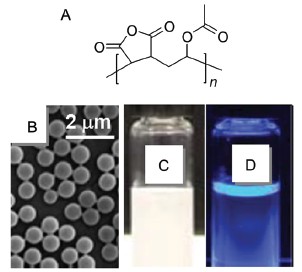| [1] Dong, J. H.; Zhang, X.; Wang, L. X. Frontier and Prospect of Polymer Science, Science Press, Beijing, 2011, pp. 409~485. (董建华, 张希, 王立祥, 高分子科学学科前沿与展望, 科学出版社, 北京, 2011, pp. 409~485.)[2] Demas, J. N.; Crosby, G. A. J. Phys. Chem. 1971, 75, 991.[3] Varnavski, O.; Ispasoiu, R. G.; Balogh, L.; Tomalia, D.; Goodson III, T. J. Chem. Phys. 2001, 114, 1962.[4] Zheng, J.; Petty, J. T.; Dickson, R. M. J. Am. Chem. Soc. 2003, 125, 7780.[5] Lee, W. I.; Bae, Y.; Bard, A. J. J. Am. Chem. Soc. 2004, 126, 8358.[6] Wang, D.; Imae, T. J. Am. Chem. Soc. 2004, 126, 13204.[7] Cao, L.; Yang, W. L.; Wang, C. C.; Fu, S. K. J. Macromol. Sci. Part A: Pure Appl. Chem. 2007, 44, 417.[8] Wang, D.; Imae, T.; Miki, M. J. Colloid Interface Sci. 2007, 306, 222.[9] Chu, C.-C.; Imae, T. Macromol. Rapid Commun. 2009, 30, 89.[10] Pastor-Pe′rez, L.; Chen, Y.; Shen, Z.; Lahoz, A.; Stiriba, S.-E. Macromol. Rapid Commun. 2007, 28, 1404.[11] Lin, S.-Y.; Wu, T.-H.; Jao, Y.-C.; Liu, C.-P.; Lin, H.-Y.; Lo, L.-W.; Yang, C.-S. Chem. Eur. J. 2011, 17, 7158.[12] Saravanan, G.; Imae, T. J. Nanosci. Nanotechnol. 2011, 11, 4838.[13] Tsai, Y.-J.; Hu, C.-C.; Chu, C.-C.; Imae, T. Biomacromolecules 2011, 12, 4283.[14] Imae, T.; Hamaguchi, S. Carbohydr. Polym. 2012, 88, 352.[15] Yang, W.; Pan, C.-Y. Macromol. Rapid Commun. 2009, 30, 2096.[16] Yang, W.; Pan, C.-Y.; Luo, M.-D.; Zhang, H.-B. Biomacromolecules 2010, 11, 1840.[17] Yang, W.; Pan, C.-Y.; Liu, X.-Q.; Wang, J. Biomacromolecules 2011, 12, 1523.[18] You, Y.-Z.; Yu, Z.-Q.; Cui, M.-M.; Hong, C.-Y. Angew. Chem. Int. Ed. 2010, 49, 1099.[19] Chen, Y.; Zhou, L.; Pang, Y.; Huang, W.; Qiu, F.; Jiang, X.; Zhu, X. Y.; Yan, D.; Chen, Q. Bioconjugate Chem. 2011, 22, 1162.[20] Wu, D. C.; Liu, Y.; He, C. B.; Goh, S. H. Macromolecules 2005, 38, 9906.[21] Wu, D. C.; Liu, Y.; Chen, L.; He, C. B.; Chung, T. S.; Goh, S. H. Macromolecules 2005, 38, 5519.[22] Sun, M.; Hong, C.-Y.; Pan, C.-Y. J. Am. Chem. Soc. 2012, 134, 20581.[23] Halpern, A. M.; Wryzykowska, K. J. Photochem. 1981, 15, 147.[24] Liu, Y.; Gao, J.-W.; Liu, H.-W.; Li, Y.-S. Macromolecules 2009, 42, 3237.[25] Restani, R. B.; Morgado, P. I.; Ribeiro, M. P.; Correia, I. J.; Aguiar-Ricardo, A.; Bonifácio, V. D. B. Angew. Chem. Int. Ed. 2012, 51, 5162.[26] Hong, Y.; Lam, J. W. Y.; Tang, B. Z. Chem. Soc. Rev. 2011, 40, 5361.[27] Zhang, S.; Qin, A.; Sun, J. Z.; Tang, B. Z. Prog. Chem. 2011, 23, 623.[28] Hong, Y. N.; Lam, J. W. Y.; Tang, B. Z. Chem. Commun. 2009, 4332.[29] Xing, C. M.; Lam, J. W. Y.; Qin, A. J.; Dong, Y. Q.; Haussler, M.; Yang, W. T.; Tang, B. Z. Polym. Mater. Sci. Eng. 2007, 96, 418.[30] Qin, A.; Lam, J. W. Y.; Tang, B. Z. Prog. Polym. Sci. 2012, 37, 182.[31] Pucci, A.; Rausa, R.; Ciardelli, F. Macromol. Chem. Phys. 2008, 209, 900.[32] Ruff, Y.; Lehn, J.-M. Angew. Chem. Int. Ed. 2008, 47, 3556.[33] Gao, L.; Fei, J. B.; Zhao, J.; Cui, W.; Cui, Y.; Li, J. B. Chem. Eur. J. 2012, 18, 3185.[34] Chen, Y.; Spiering, A. J. H.; Karthikeyan, S.; Peters, G. W. M.; Meijer, E. W.; Sijbesma, R. P. Nat. Chem. 2012, 4, 559.[35] Yan, J.-J.; Wang, Z.-K.; Lin, X.-S.; Hong, C.-Y.; Liang, H.-J.; Pan, C.-Y.; You, Y.-Z. Adv. Mater. 2012, 24, 5617. |
